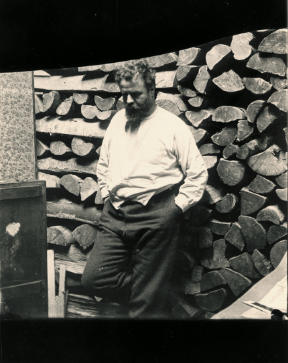

Medardo Rosso
1858 – 1928

| 1858 | Medardo Rosso born in Turin on June 21st. | |
| 1870 | The family moves to Milan | |
| 1882 | He attends the Accademia di Belle Arti di Brera in Milan. | |
| 1883 | Rosso participates in the “Esposizione Internazionale di Belle Arti” in Rome. In March he is expelled from the Accademia, for leading a petitions complaining about the school hours and the lack of anatomic preparations to copy from life. | |
| 1885 | In April he marries Giuditta Pozzi in Milan. In November his son Francesco Luigi Domenico is born, registered under the name of Francesco Evviva Ribelle. | |
| 1886 | Rosso begins an intellectual relationship with the writer and critic Felice Cameroni. | |
| 1888 | He takes part in the “Italian Exhibition” in London organised by Alberto Grubicy. | |
| 1889 | In April, Rosso separates from his wife and he leaves for Paris accompanied by Felice Cameroni who introduced him to the political and literary scene where he meets Emile Zola, Edmond de Goncourt and Paul Alexis. He participates in the “Exposition Universelle” with five bronzes. He definitely moved to Paris. | |
| 1890 | He befriends the industrialist and art collector Henri Rouart, who buys some of his works. During this year, he travels to Milan to visit his son | |
| 1894 | As a sign of mutual respect, Rosso gave his bronze of Rieuse to Rodin in exchange for a Torso by the French sculptor. | |
| 1898 | Relations between Rosso and Rodin start to deteriorate, while French criticism on the topic of the presumed influence of Rosso on the French sculptor starts to appear. | |
| 1900 | He meets Etha Fles, Dutch art critic, writer and artist, with whom he begins a long intellectual and affective relationship. | |
| 1904 | He participates in the Salon d’Automne in Paris, presenting a significant selection of sculptures, photographic enlargements and coloured prints on chamois paper that look like drawings. | |
| 1905 | Rosso inaugurates a solo exhibition at Artaria’s Kunstsalon including sculptures and copies from antiques. | |
| 1906 | As guest of the great collector Ludwig Mond in London, Rosso sculpts the portrait of Mond’s grandson Alfred, later entitled Ecce Puer. His solo exhibition opens at the Eugène Cremetti Gallery with twenty-two works (waxes, bronzes, drawings and copies from antiques). | |
| 1907 | He came back to Italy to visit his son after seventeen years. | |
| 1910 | The “Prima Mostra italiana dell’Impressionismo e di Medardo Rosso” is inaugurated in Florence. | |
| 1911 | He takes part at “Esposizione Internazionale di Belle Arti” in Rome. | |
| 1913 | Etha Fles, before departing from Italy, arranges to leave works of the artist to Italian museums such as Rome, Turin, Milan and Venice. | |
| 1915 | Italy enters the war. During these years Rosso lives between Venice, Milan, Paris and Leysin, in Switzerland, where he often goes to visit Etha Fles who had moved there. | |
| 1920 | Rosso moves to Milan. He strengthens his friendship with Carlo Carrà and Margherita Sarfatti. | |
| 1923 | Rosso had an important personal exhibition at the Galleria Bottega di Poesia. | |
| 1926 | Margherita Sarfatti organizes the Prima mostra del Novecento Italiano in the Palazzo della Permanente in Milan, where Rosso has a dedicated room. | |
| 1928 | After suffering from diabetes for many years, he dies on March 31st |
1858
Medardo Rosso born in Turin on June 21st.
1870
The family moves to Milan.
1882
He attends the Accademia di Belle Arti di Brera in Milan.
1883
Rosso participates in the “Esposizione Internazionale di Belle Arti” in Rome. In March he is expelled from the Accademia, for leading a petitions complaining about the school hours and the lack of anatomic preparations to copy from life.
1885
In April he marries Giuditta Pozzi in Milan. In November his son Francesco Luigi Domenico is born, registered under the name of Francesco Evviva Ribelle.
1886
Rosso begins an intellectual relationship with the writer and critic Felice Cameroni.
1888
He takes part in the “Italian Exhibition” in London organised by Alberto Grubicy.
1889
In April, Rosso separates from his wife and he leaves for Paris accompanied by Felice Cameroni who introduced him to the political and literary scene where he meets Emile Zola, Edmond de Goncourt and Paul Alexis. He participates in the “Exposition Universelle” with five bronzes. He definitely moved to Paris.
1890
He befriends the industrialist and art collector Henri Rouart, who buys some of his works. During this year, he travels to Milan to visit his son.
1894
As a sign of mutual respect, Rosso gave his bronze of Rieuse to Rodin in exchange for a Torso by the French sculptor.
1898
Relations between Rosso and Rodin start to deteriorate, while French criticism on the topic of the presumed influence of Rosso on the French sculptor starts to appear.
1900
He meets Etha Fles, Dutch art critic, writer and artist, with whom he begins a long intellectual and affective relationship.
1904
He participates in the Salon d’Automne in Paris, presenting a significant selection of sculptures, photographic enlargements and coloured prints on chamois paper that look like drawings.
1905
Rosso inaugurates a solo exhibition at Artaria’s Kunstsalon including sculptures and copies from antiques.
1906
As guest of the great collector Ludwig Mond in London, Rosso sculpts the portrait of Mond’s grandson Alfred, later entitled Ecce Puer. His solo exhibition opens at the Eugène Cremetti Gallery with twenty-two works (waxes, bronzes, drawings and copies from antiques).
1907
He came back to Italy to visit his son after seventeen years.
1910
The “Prima Mostra italiana dell’Impressionismo e di Medardo Rosso” is inaugurated in Florence.
1911
He takes part at “Esposizione Internazionale di Belle Arti” in Rome.
1913
Etha Fles, before departing from Italy, arranges to leave works of the artist to Italian museums such as Rome, Turin, Milan and Venice.
1915
Italy enters the war. During these years Rosso lives between Venice, Milan, Paris and Leysin, in Switzerland, where he often goes to visit Etha Fles who had moved there.
1920
Rosso moves to Milan. He strengthens his friendship with Carlo Carrà and Margherita Sarfatti.
1923
Rosso had an important personal exhibition at the Galleria Bottega di Poesia.
1926
Margherita Sarfatti organizes the Prima mostra del Novecento Italiano in the Palazzo della Permanente in Milan, where Rosso has a dedicated room.
1928
After suffering from diabetes for many years, he dies on March 31st
